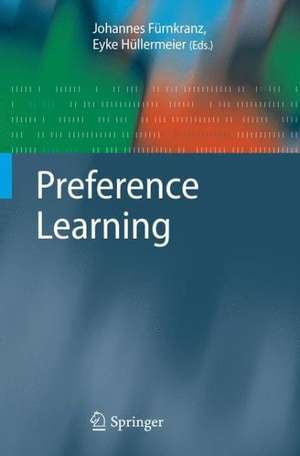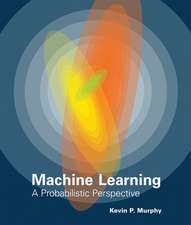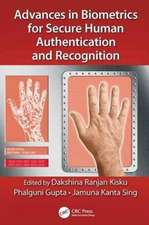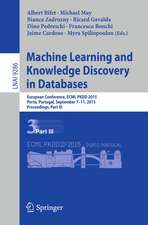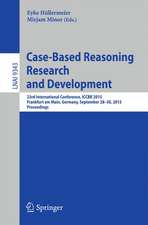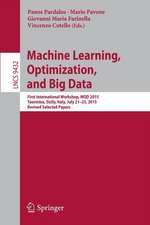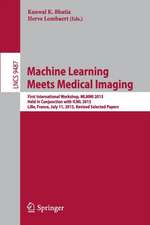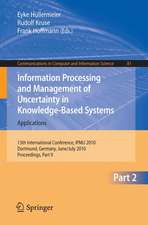Preference Learning
Editat de Johannes Fürnkranz, Eyke Hüllermeieren Limba Engleză Paperback – 28 sep 2014
| Toate formatele și edițiile | Preț | Express |
|---|---|---|
| Paperback (1) | 1052.82 lei 6-8 săpt. | |
| Springer Berlin, Heidelberg – 28 sep 2014 | 1052.82 lei 6-8 săpt. | |
| Hardback (1) | 1058.42 lei 6-8 săpt. | |
| Springer Berlin, Heidelberg – 10 oct 2010 | 1058.42 lei 6-8 săpt. |
Preț: 1052.82 lei
Preț vechi: 1316.03 lei
-20% Nou
Puncte Express: 1579
Preț estimativ în valută:
201.55€ • 207.39$ • 169.89£
201.55€ • 207.39$ • 169.89£
Carte tipărită la comandă
Livrare economică 01-15 martie
Preluare comenzi: 021 569.72.76
Specificații
ISBN-13: 9783642422300
ISBN-10: 3642422306
Pagini: 476
Ilustrații: IX, 466 p.
Dimensiuni: 155 x 235 x 25 mm
Greutate: 0.66 kg
Ediția:2011
Editura: Springer Berlin, Heidelberg
Colecția Springer
Locul publicării:Berlin, Heidelberg, Germany
ISBN-10: 3642422306
Pagini: 476
Ilustrații: IX, 466 p.
Dimensiuni: 155 x 235 x 25 mm
Greutate: 0.66 kg
Ediția:2011
Editura: Springer Berlin, Heidelberg
Colecția Springer
Locul publicării:Berlin, Heidelberg, Germany
Public țintă
ResearchCuprins
Preference Learning: An Introduction.- A Preference Optimization Based Unifying Framework for Supervised Learning Problems.- Label Ranking Algorithms: A Survey.- Preference Learning and Ranking by Pairwise Comparison.- Decision Tree Modeling for Ranking Data.- Co-regularized Least-Squares for Label Ranking.- A Survey on ROC-Based Ordinal Regression.- Ranking Cases with Classification Rules.- A Survey and Empirical Comparison of Object Ranking Methods.- Dimension Reduction for Object Ranking.- Learning of Rule Ensembles for Multiple Attribute Ranking Problems.- Learning Lexicographic Preference Models.- Learning Ordinal Preferences on Multiattribute Domains: the Case of CP-nets.- Choice-Based Conjoint Analysis: Classification vs. Discrete Choice Models.- Learning Aggregation Operators for Preference Modeling.- Evaluating Search Engine Relevance with Click-Based Metrics.- Learning SVM Ranking Function from User Feedback Using Document.- Metadata and Active Learning in the Biomedical Domain.- Learning Preference Models in Recommender Systems.- Collaborative Preference Learning.- Discerning Relevant Model Features in a Content-Based Collaborative Recommender System.- Author Index.- Subject Index
Recenzii
From the reviews:
“The book looks at three major types of preference learning: label ranking, instance ranking, and object ranking. … chapters contain case studies and actual experiments to illustrate the claims made within. … this is a useful book in an emerging and important area, and hence would be of interest to machine learning researchers. The book is quite readable to that audience, despite a heavy emphasis on formal treatment.” (M. Sasikumar, ACM Computing Reviews, September, 2011)
“The book looks at three major types of preference learning: label ranking, instance ranking, and object ranking. … chapters contain case studies and actual experiments to illustrate the claims made within. … this is a useful book in an emerging and important area, and hence would be of interest to machine learning researchers. The book is quite readable to that audience, despite a heavy emphasis on formal treatment.” (M. Sasikumar, ACM Computing Reviews, September, 2011)
Textul de pe ultima copertă
The topic of preferences is a new branch of machine learning and data mining, and it has attracted considerable attention in artificial intelligence research in recent years. Representing and processing knowledge in terms of preferences is appealing as it allows one to specify desires in a declarative way, to combine qualitative and quantitative modes of reasoning, and to deal with inconsistencies and exceptions in a flexible manner. Preference learning is concerned with the acquisition of preference models from data – it involves learning from observations that reveal information about the preferences of an individual or a class of individuals, and building models that generalize beyond such training data.This is the first book dedicated to this topic, and the treatment is comprehensive. The editors first offer a thorough introduction, including a systematic categorization according to learning task and learning technique, along with a unified notation. The remainder of the book is organized into parts that follow the developed framework, complementing survey articles with in-depth treatises of current research topics in this area.The book will be of interest to researchers and practitioners in artificial intelligence, in particular machine learning and data mining, and in fields such as multicriteria decision-making and operations research.
Caracteristici
This is the first book dedicated to this topic This topic has attracted considerable attention in artificial intelligence research in recent years A comprehensive treatment Includes supplementary material: sn.pub/extras
